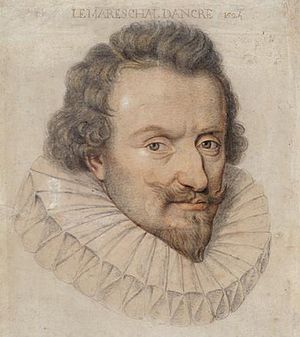Concino Concini facts for kids
Quick facts for kids
Concino Concini
|
|
|---|---|

Portrait by Daniel Dumonstier (1614)
|
|
| Informal Chief Minister to the French Monarch | |
| In office 1610–1617 |
|
| Monarch | Louis XIII Marie de' Medici (regent) |
| Preceded by | Maximilien de Béthune, duc de Sully |
| Succeeded by | Armand-Jean du Plessis, Cardinal Richelieu (1624) |
| Personal details | |
| Born | 23 November 1569 Terranuova Bracciolini, Grand Duchy of Tuscany |
| Died | 24 April 1617 (aged 47) Paris, Kingdom of France |
| Spouse | Leonora Dori |
| Children | Henri Concini |
Concino Concini (born November 23, 1569 – died April 24, 1617) was an Italian politician. He became very powerful in France as a close adviser to Marie de' Medici, the Queen Mother and regent for young King Louis XIII. Concini was killed in 1617 on the King's orders.
Contents
Concini's Early Life and Rise to Power
Concino Concini was born in Florence, a city in Italy, on November 23, 1569. In the year 1600, he traveled to France with Maria de Medici. She was about to marry King Henri IV. Concini's wife, Leonora Dori, was a lady-in-waiting to the Queen. People believed that Leonora's close friendship with the Queen, along with Concini's own cleverness, helped him become very successful.
In 1610, Concini bought the title of Marquis of Ancre. He also gained an important position at court. Over the next few years, he received more powerful roles. These included being in charge of important areas like Amiens and Normandy. By 1613, he even became a Marshal of France, a very high military rank.
How Concini Gained Political Influence
At first, Concini and his wife focused on making their family rich. They used Leonora's close connection to the Queen to gain wealth. However, Concini's political power grew slowly. From 1610 to 1614, most of the real political decisions were still made by other ministers.
Between 1614 and 1616, Concini's influence became much stronger. He became involved in important royal marriages and dealt with rebellious princes. By 1615, many people started to criticize him. After a peace agreement called the Treaty of Loudun in 1616, Concini truly held great power in France.
He and his wife wanted to make the King's power stronger. They removed some of King Henri IV's old ministers. They also had a powerful prince, Henry II de Bourbon, arrested. Concini even helped Cardinal Richelieu begin his political career. A new group of ministers was formed, with Concini at the center of power.
The End of Concini's Power
By 1617, young King Louis XIII was tired of Concini's control. The King was encouraged by his own close friend, Charles de Luynes. Louis XIII secretly ordered the head of his royal guards, Nicolas de L'Hôpital, to arrest Concini.
Concini was stopped on a bridge near the Louvre castle. He was killed by the guards. Some say he called out for help, which was seen as resisting arrest. This action was part of a secret plan by King Louis and de Luynes. Concini was seen as a threat to the King. He was a very powerful politician with many supporters and even his own small army.
After Concini's death, the Queen Mother, Marie de' Medici, was sent away from Paris. She had to live in Blois. Concini's wife, Leonora Dori, was arrested. She was accused of strange practices and was later executed. Concini's son, Henri, who was born in 1605, left France and died in Florence in 1631. All of the Concini family's wealth and properties were taken by King Louis XIII. They were then given to Charles de Luynes.
After Concini's death, many stories and pamphlets were spread in Paris. These tried to explain and justify why he had been killed.
See also
 In Spanish: Concino Concini para niños
In Spanish: Concino Concini para niños



